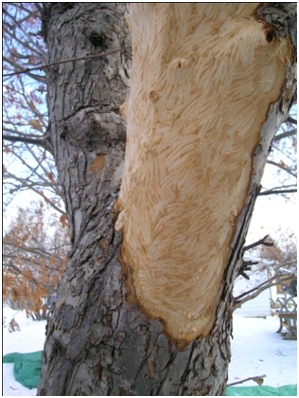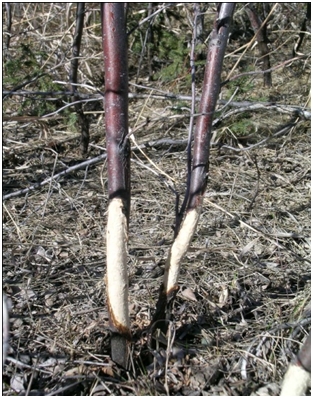Many animals leave their signs on trees. Squirrels, voles and porcupines may chew off bark for food or medication. Sapsuckers (a type of woodpecker) drill holes in thin-barked trees such as birch to drink tree sap and eat the insects attracted to the ooze. Honeysuckles and other shrubs with shredding bark may be stripped by birds for nesting material. Deer or moose may rub their antlers on trees, wearing the bark off.
Tree Damage
The height and pattern of damage and the type of tree may reveal the animal responsible. Minor bark damage will eventually be covered over by a healthy tree. Chewing or damage that completely encircles a stem or trunk will result in the death of that stem or branch above the damage. This could be the whole tree.
Key Points
- Voles, Squirrels, Porcupine, Rabbits and Birds can all cause damage to trees.
- Damage to the main stems and trunk can cause problems, especially for younger trees.
- Tree protectors or repellents can be used to deter the animals. If all else fails fences or other barriers can be used.
Squirrel damage is usually revealed as chewed areas, often high in a tree and on the upper surface of a branch. Unless the damage completely encircles a branch, the tree will probably cope with the wound.
Porcupine damage can be extensive. Long chiseled tooth marks are distinctive.

Voles are small rodents that resemble burly mice. Voles do not climb trees but may chew off the bark at the base of small trees or shrubs during winter. Stems that are completely girdled by chewing will die. Voles rely on the cover of snow, mulch or dense shrubbery around the base of a small tree to access the bark. Hares may also chew the bark from thin-barked young trees in winter.

Bird damage on honeysuckle or other shaggy barked shrubs can be quite remarkable. Unless the birds are seen collecting the bark shreds for nesting, it’s hard to believe a bird could be responsible. Shredded bark at the base of a honeysuckle could be caused by cat scratching, as some cats are attracted to honeysuckle.


Sapsucker damage on birch. One or more evenly spaced rows of holes that resemble nail holes reveal sapsucker activity.
Control Measures
- Voles can be trapped like mice.
- Protect small trees and shrubs by keeping mulch away from the base of stems in winter. Pack snow down around trunks to deny voles a pathway under snow cover.
- Use plastic tree protectors or make cages of chicken wire around trunks to deny hares access to bark.
- Use a commercial animal repellent such as Plantskydd.™
- Erect fences and barriers.

